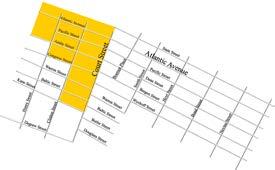HISTORIC PRESERVATION STUDIO II
Social History and Neighborhood Development Germans Beginning in the 1840s large numbers of German immigrants entered the United States. In the 1850s alone, 800,000 Germans passed through New York. By 1855 New York had the third largest German population of any city in the world, outranked only by Berlin and Vienna.1 The earliest Germans in Brooklyn can be traced back before the War for Independence, and this group started to contribute to the development of New York City before the change of government relegated the name “New Amsterdam”. Many people believe that the first Germans settled in New York as early as the Dutch did. However, this claim has not yet been proven true, except for a line written in the Brooklyn Daily Eagle in January 1910: “Peter Minuit was not the only German in the service of the Dutch West India Company when it began the exploitation of the lands about the estuary of the Hudson River.”2 In Brooklyn, the Germans were among a predominant group of European newcomers. Germans fleeing the disruption of a failed revolution poured into the city around the middle of the 19th century.3 “In 1855, nearly half of Brooklyn's 205,000 residents were foreign-born; about half were Irish, with the rest evenly divided between Germans and Britons.”4 Also, in late 20th century, second generation German-Americans relocated themselves to Brooklyn. The German community was especially strong in the eastern part of Brooklyn, in Williamsburg, Bushwick, and Greenpoint, and some of them settled in Redhook.
Germans and Industry German laborers working in the shipping industry commonly resided in Cobble Hill, where there was a high concentration of German immigrants. The Germans laborers brought with them religious traditions and architecture. The best examples are churches, particularly the Lutheran and Reformed. In Brooklyn, German churches connected with every religious denomination. Of the many denominations, the Lutherans were the strongest, though the Reformed Church, which came in with the Dutch, have a prior establishment.
Trinity Lutheran German Church Source: Brooklyn Daily Eagle
The oldest German Evangelical church was just out of the study area on Schermerhorn Street, near Court Street, and it does not represent the first efforts to establish a Lutheran church in Brooklyn. The first congregation met in the old courtroom, on the corner of Cranberry and Fulton streets as early as 1841. The church was built in 1845 and then enlarged in 1865. In 1888 the congregation had outgrown the old structure and new edifice was built as replacement. Despite immense importance to the congregation, the building is now demolished.
1 Burrows, Edwin G, Gotham : a history of New York City to 1898, (New York : Oxford University Press, 1999) 2 Brooklyn Daily Eagle, 30 jan 1910, Brooklyn Historic Society 3 "History of Brooklyn." Thirteen: Media with Impact. 2016. Accessed April 25, 2016. http://www.thirteen.org/brooklyn/history/history3.html 4 ibid
A STUDY OF BROOKLYN’S COBBLE HILL & BOERUM HILL NEIGHBORHOODS 53




















